Hi! I write reviews for some of the stuff I play! (she/her)
Don't wanna be here? Send us removal request.
Text
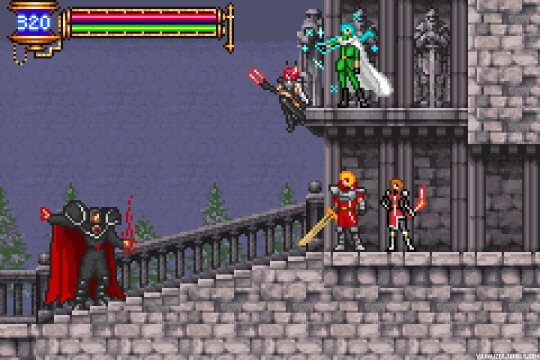
Chazlevania, now with Zio (based on Dracula), Alys (Yoko), Rune (Genya) and Rika (one of those broom-flying witches because Mina doesn't really look anything like her)!
Never really thought of it before but Soma's kind of chunky compared to the rest of the human sprites. Chaz really shouldn't be that buff... Oh well!
32 notes
·
View notes
Photo
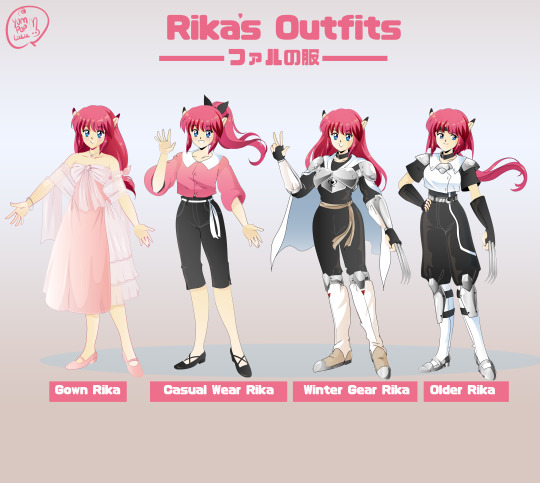
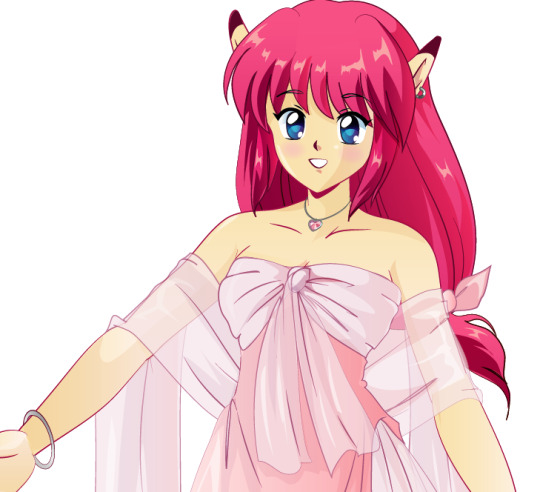
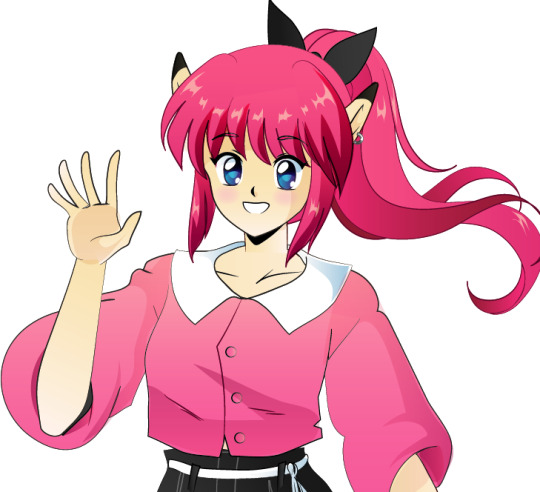
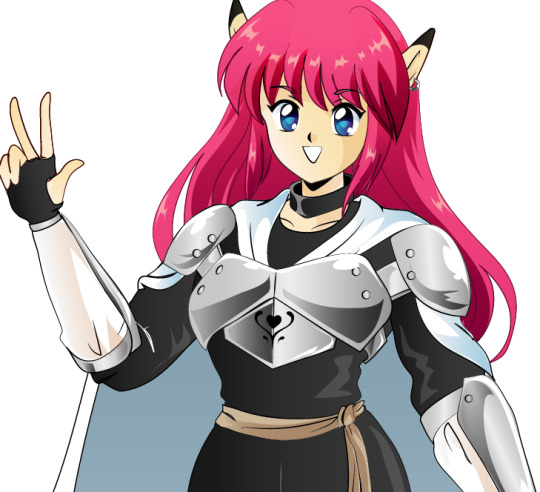
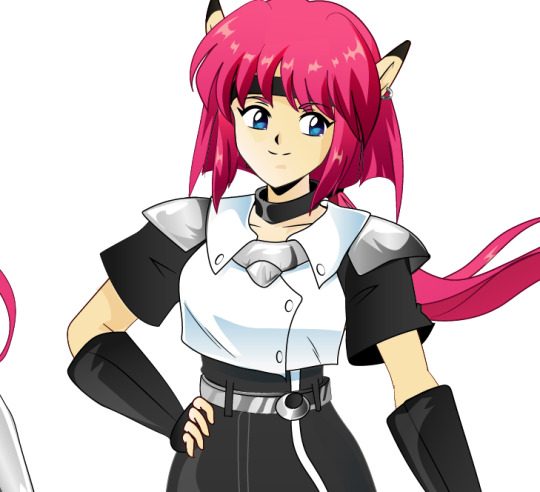
Rika from Phantasy Star 4 in her extra costumes that only exist in the art books and end cut scene. These drawings and poses are heavily based on Yoshibon’s production materials. I’m having a huge art block rn but drawing fun fashion makes me feel better somewhat ;-;
24 notes
·
View notes
Text
Shin Megami Tensei (SNES) review - the best and worst game I've ever played
I have finished my first Shin Megami Tensei game - the original! As you can tell from the post's title, it is... well... It's both the best, and worst game I have ever played!
Okay okay all jokes aside, I have a few issues with the game - and not *just* because it's old - but overall I still enjoyed my experience!
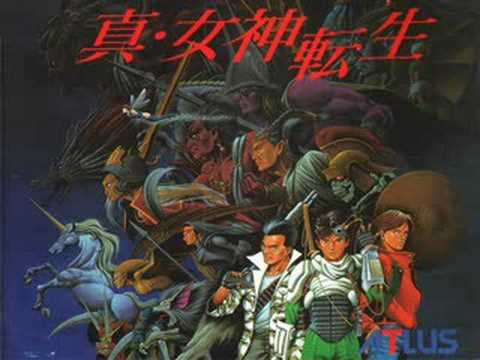

...which is good, because said enemies are REALLY tough! Now, that is somewhat expected from a JRPG from the very early 90s, but I honestly think SMT1 does it better than a few games of its era! Why? Well, while the encouter rate is very high, you always have a chance at talking demons into leaving you alone, on top of escaping! Plus, what I ended up loving about the SMT formula is how... useful buffs and debuffs can be! (with one caviat, more on that later) Basically, any buffs your human party members or demons can use are very cheap, you usually have lots of MP to use them and they finally tend to be very useful anyway! Enemies are generally much more threatening than in your average JRPG, so putting 5 or 6 of them to sleep all at once is VITAL if you want to survive! All of these factors combined make SMT a very tense and exhilarating experience, and I loved it! Although... a side effect of this is that backtracking tends to suuuuuuck (I never got the chance to get a Estoma spell ;-;) Sadly, I can NOT say the same for most of the bosses. On one hand, the game's lack of checkpoints makes me glad they aren't a nightmare, but... to put it simply, every boss in the game is weak to stunning, which means that if you use a human's Thunder spell on a boss at every turn, you can literally stun them for the ENTIRE BATTLE. And even if this cheese did not exist, they tend to not have enough HP to be much of a threat anyway!

And unfortunately, this is not the only gameplay issue I have with SMT1. First off, the game is not always obvious about where you need to go next - which to be fair, was a common thing at the time - but I still ended up needing to pull a guide a few times due to how unintuitive progression could feel ><
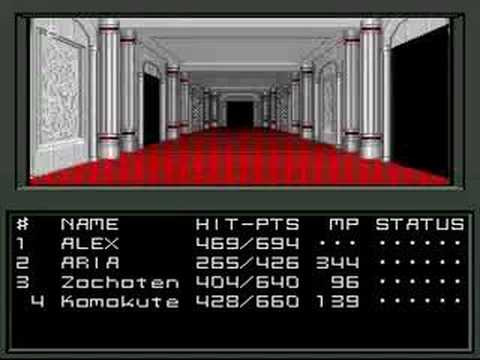
And... to put it shortly, the dungeon design is not very good. At first, it's not so bad, with a few small floors to deal with at a time... but eventually you'll have to bother with MASSIVE labyrinths, that are sometimes filled with traps, one way doors, pitfalls, warp tiles... yuck, it's so annoying! I'm at least grateful the game was smart enough to include a map feature ^^' The dungeons also tend to look a lot like each other - not to the point of Phantasy Star of course, but there is a loooot of palette swaps going on with the various places you explore, and it kinda blows ;-;
Also, the Cathedral sucks. Period. It looks cool, but it sucks. Moving on...
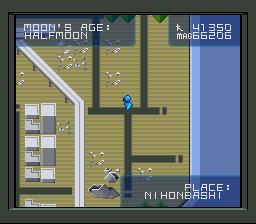
I'd say that besides those quirks, the game actually looks pretty okay! Definitely a little washed out a simple, but the demon's sprites can be absolutely killer to look at! As far as the music goes, well... I'm actually really mixed about it? The thing that annoys me the most about SMT1's soundtrack - besides how the songs always reset whenever you enter a battle - is that... well, a good chunk of the songs loop after only a few seconds! But on the flip side, they're like, the best 10 or 20 second loops you'll ever hear in your life? I'm really confused >< Needless to say, my favourite track in the game in Ginza - because it's a banger that actually lasts a minute before looping!
Finally, I do not like to talk about the story in those kinda reviews for spoiler reasons, but I'll keep it short: for 1992, this is actually really nice! I very much enjoyed how unsettling and dark a good chunk of it felt, how chaotic things could turn, and.. honestly, the game had a lot of really impactful moments and events - despite how SMT1 doesn't have much dialogue for the most part. It's kinda like Phantasy Star II really! But not as impactful I guess

But, here's an important deal about said story: the neat thing that SMT does narrative-wise is alignment! Basically, depending on your choices during the game, your alignment can tip between Law, Neutral, and Chaos. And although the general adventure will mostly stay the same, changing your alignment will have an impact on which demons you can recruit, which bosses you'll fight - and even how you'll progress in the final dungeon! I personally wish they had just a liiiiiittle more impact on the narrative, but it's still a very neat way to encourage replayability, I think! (For those curious, I decided to go Law, and was kinda disappointed by the ending not gonna lie...)
So... yes. Shin Megami Tensei is a game with a LOT of really cool elements and powerful strengths, but it's also bogged down by a LOT of annoyances that really made me not like the game as much as I should have ;-; But I can totally see why people like this series from the tense, unique twist on classic JRPG gameplay alone!
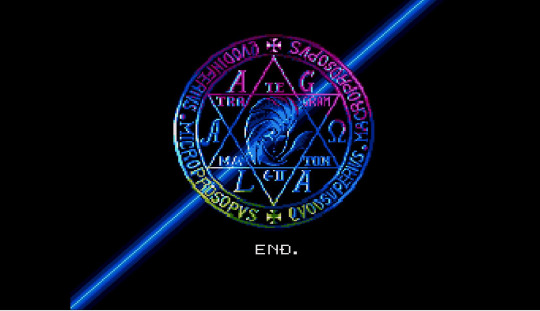
Though it is simultaneously the best and worst game I've ever played, I will definitely play more of the series in the future!
Rating: 7/10
1 note
·
View note
Text

GameBoyCatgirl.jpeg
10 notes
·
View notes
Text

13 notes
·
View notes
Text
Touhou VI: The Embodiment of Scarlet Devil - or my first journey into a bullet hell game
Touhou is that one pew pew game series with cute anime gals, right?
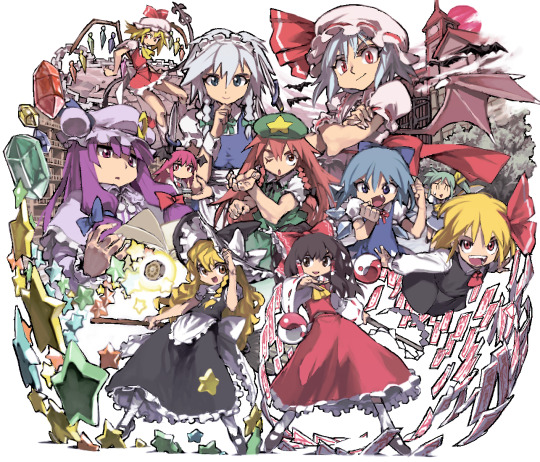
Source: https://pixiv.kurocore.com/illust/54033795
Just like what I think are many people, that’s pretty much all I knew about the franchise as a whole! And to be honest, for a long long time, I was AFRAID of going any closer to anything Touhou-related! Because of them being bullet hecks, they seemed like the most frustrating and unfun games I could possibly be playing! But then... time passed... Fast forward to somewhere in 2020: I was watching the biyearly Games Done Quick event, and one of the first runs showcased during it was none other than Touhou Luna Nights! But while the speedrun itself was very impressive, the thing that really captivated me was well... everything else! Even though this was only a Metroidvania fangame, IT LOOKED LIKE SO MUCH FUN! The graphics, the special effects, the mechanics... everything just seemed like a dream! In spite of that, I only picked the game up and played it about a year later, thanks to a Steam sale! And to keep things short, I ADORED it. It was a bit too short, but everything else was spot on, and even better than I thought it would be from what I saw at GDQ! But that’s sadly a review for another time :( Because I literally fell in love in this game, well... I thought “screw it, I’ve been morbidly curious for years now, let’s actually try a freakin’ Touhou game!”
And so, after some research I’ve learned that the sixth game - the first one released on Windows PCs! - was the one that served as inspiration for Luna Nights as a whole - its characters, music, stage aesthetics and more! It just seemed natural to settle with this one~
How did it go? What did I think about it? Well, that’s why we’re here: those are my thoughts about Touhou VI: the Embodiment of Scarlet Devil.
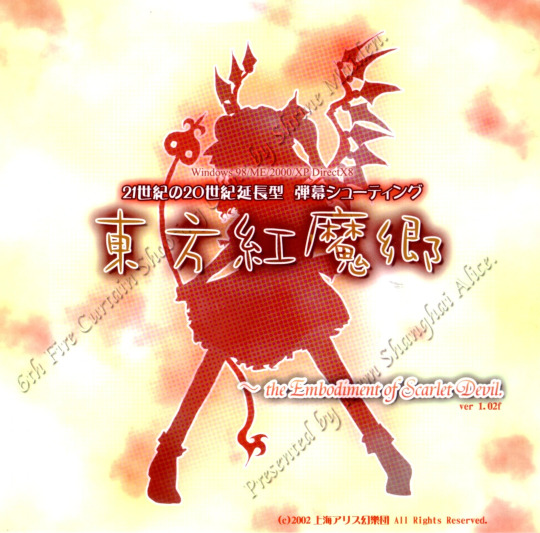
Now for a pointless history lesson: as I said earlier, Touhou 6 was the very first game published for Windows PCs, all the way back in 2002! The five previous games were actually exclusive to a Japan-only machine, the NEC PC-98, a line that prevailed strongly in Japan before Microsoft conquered the world. As such, it’s really the first game that’s still relatively accessible today, as PC-98 emulation is... not really a stable thing yet -_- So even though this wasn’t quite true, it’s as if I started my journey into Touhou with the original! And once I started playing, I was honestly surprised at one thing once I hit the title screen: this game actually has lots of options to make the experience easier or harder!
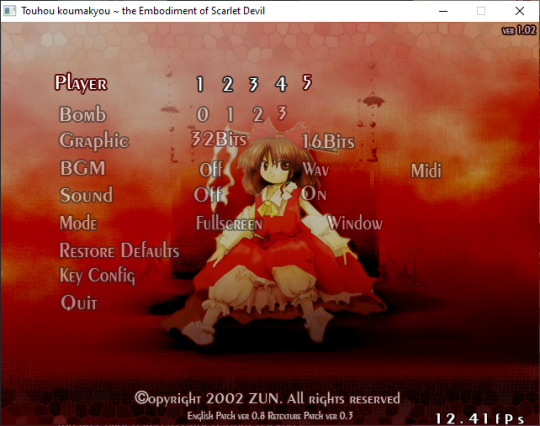
I know that being able to change your starting lives, starting bombs, choose your overall difficulty and such isn’t groundbreaking at all, but honestly? I didn’t expect things to be so customisable in a bullet heck game series - a genre that’s known for being merciless to players! I did decide to go on Normal to have the “intended” experience, but things aren’t as daunting as you may think!
This game also allows you to play as not only Reimu, the poster character of the franchise, but also Marisa! Both of these girls also boasts two different weapons each, with their own strengths, weaknesses and bomb attacks! Again, I genuinely did not expect so much breathing room even though looking back... I feel like I should have : P
Once I actually started playing the game itself, there’s yet another thing that surprised me: the difficulty curve... it’s... manageable??
Now granted, I’m a person that plays a *lot* of games, and on top of that, I play lots of action games as well, games that require quick reaction times, good pattern reading and so on so forth. So there’s a chance my judgement on the game’s difficulty might be wrong or biased... but to me? Embodiment of Scarlet Devil actually has a good difficulty curve! The first stage of the game has many enemies that can shoot many bullets, but they’re slow, predictable and relatively easy to avoid because you have lots of space to maneuver around! On that same train of thought, Rumia, the first stage’s boss, certainly doubles down on the number of bullets she can throw at you. But, their patterns are once again pretty slow and predictable, making things much more comfortable at the start of your adventure!
But hold on a minute here, how does this game actually plays? Well, this is where I need to let out a horrifying truth:
Touhou is actually really, REALLY fun.
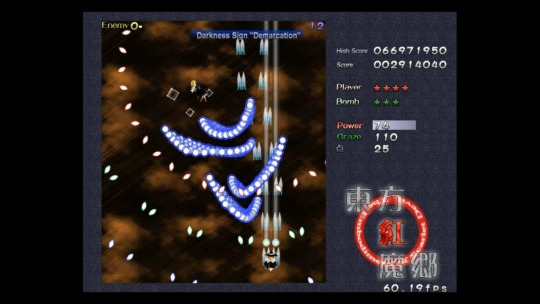
At first it does seem like a pretty standard shooter: you shoot at things, dodge bullets, collect power ups to boost your weapon’s strength, and make sure you don’t die too much in order to reach the final boss in good shape. However, what I ended up loving about Touhou are its many, many mechanics that spice things up beautifully! The first one I wanna focus on is “Grazing” and it’s actually pretty simple: if you do your best to get close to a bullet or a laser without touching it with your (very small!) hitbox, you graze that bullet! Not only will a satisfying sound effect play out each time you graze something, you will also gain points each time you do this maneuver, making it essential for a high score, and especially, to gain extra lives faster! Secondly, there’s bombing! I am totally repeating myself here, but while each character has a different kind of bomb to their disposal, they each function in relatively the same way: you get to launch a strong attack against your opponents, get invincibility frames, and on top of that, get rid of any bullets that are currently on the screen! I love bombs in this game because they create a great balance: you can totally use them for offensive purposes, buuuut they also serve as a great defensive clutch if you just find things too difficult at the moment. Bombs even have two extra layers to them! When you will get hit and lose a life (and believe me, you will) your bombs will get refilled back to three, urging you to not hoard them too much even if you’d prefer to save them for a tougher part. Because if you die, you might just “waste” bombs in a way! However, here’s an advanced kicker: if you manage to hit the bomb button just as you are hit by a projectile (8 frames within death I think!) you not only are able to save yourself from losing a life, you also won’t lose a bomb at all, either! This is a very difficult trick, but a very cool and potentially important one if you plan things out in the heat of battle ^^
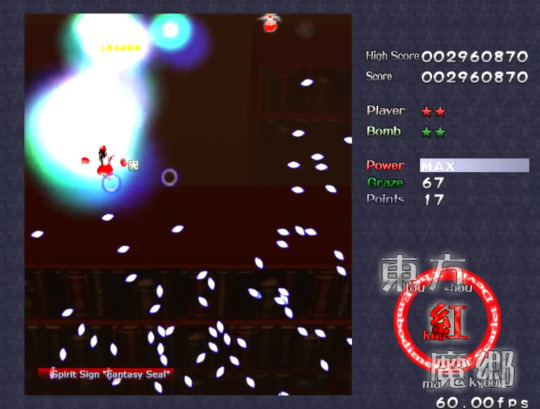
Then there’s a mechanic that, to my knowledge, got introduced in EOSD: the POC, as in Point Of Collection! Now, as you destroy the many enemies after Reimu or Marisa, they naturally drop many power ups and point icons, and because there’s many of these you’re bound to miss them. However, this is where the POC comes in: if you are at full weapon power, you will earn the ability to collect every icon on the screen! This makes sense and is actually very smart, because most players - myself included - tend to hug the bottom of the screen as bullets are more scarce and slower here. BUT reaching that POC close to the top of the screen is a great way to incentivise players to risk things in order to get a massive amount of points and gain extra lives way faster! And finally, as soon as you do reach that max power, the game will automatically wipe every single projectile off the screen, so it’s even possible to time when you’ll get your final power boost to make things easier on yourself!
All of those mechanics together make Touhou EOSD a pure joy to play! It’s simple on the surface but has such interesting mechanics and risk-reward elements that can push you out of your comfort zone, but never forces you to! And sure enough, I got addicted~
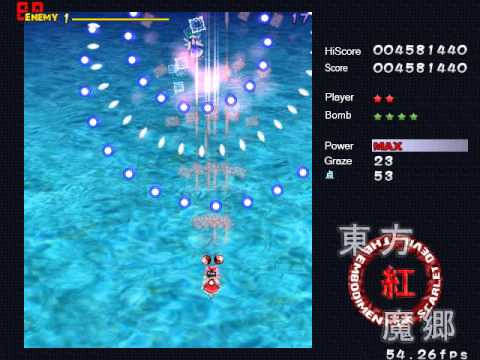
Even though I did say that the game had a good curve and started off not too difficult, it does not mean that your journey will be easy: even early game bosses such as Cirno and Meiling took me lots of practice to get consistent at, by studying their patterns and testing out which strategies worked the best for survival. And eventually, even Patchouli and Sayaka’s stages will test you out with lots of predictable-yet-deadly bullets to test out your screen reading skills and even reflexes.
Touhou may be more accessible than I thought, but do not be mistaken: on Normal, this game will still challenge you, and I absolutely love it for that <3
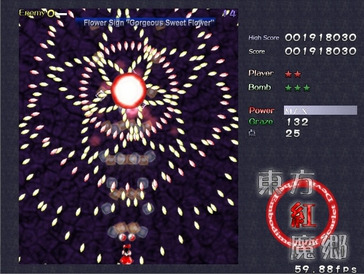
Another thing that helps this game out is - please pretend to be surprised - the music. Touhou has always been known for bringing some very good tunes all around, but besides Luna Nights’s incredible soundtrack, I actually never got to listen to any of them besides Bad Apple and one fanime opening my bestie sent me one year ago. And well... it’s true!
The game uses some very artificial, even out-of-tune instruments for its music, but strangely enough, it REALLY works! It gives the music a very nostalgic, warm feeling that’s hard to describe, but it works so well at making those songs catchy as all heck! It also helps that the compositions themselves are pretty strong and surprisingly complex for its genre, too! I would pick a favourite theme to show off, but the soundtrack’s just really consistent and good all around!
Sadly, I mostly cannot say the same for the game’s presentation. This game is a PC app from 2002 and it sadly somewhat shows. I’ll even bring a special mention to the in-game portraits, which are hilariously HORRIBLE! Thankfully dedicated fans have made a patch to improve the game’s visuals so that they’re more in line with later titles, but at base it’s really not the prettiest gem visually...
...except for the spell cards, the bosses’s strongest attacks, which are genuinely gorgeous multicolored motives that will struck you in awe before you are inevitably destroyed by them, it’s great! My favourite is the one you get from Meiling’s mid stage encounter, pictured above!

Before wrapping up this long, long post, I do wanna add this: the game will unfortunately only give you the good ending only by playing on Normal and above, and only if you beat the game without using any continues. This is called a 1CC, or 1 Credit Clear. Even if I don’t think the bad ending’s actually that unsatisfactory, I did want to get better at the game! So I practiced for many hours a day for a couple of weeks, memorized each boss’s patterns, learned where to graze, when to optimally reach the POC to get as many points as possible... this game pushed me to get better with an incentive, a reward waiting at the end, on top of the satisfaction of simply cheesing what used to be so difficult at some point and... well, I think this is the proof of a well-crafted game right there. After many failed attempts, I finally managed to 1CC this game (pictures below!!) and it was, genuinely, one of the most satisfying moments in my gaming life <3
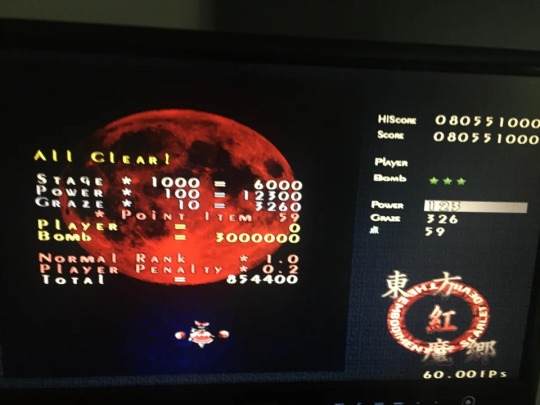
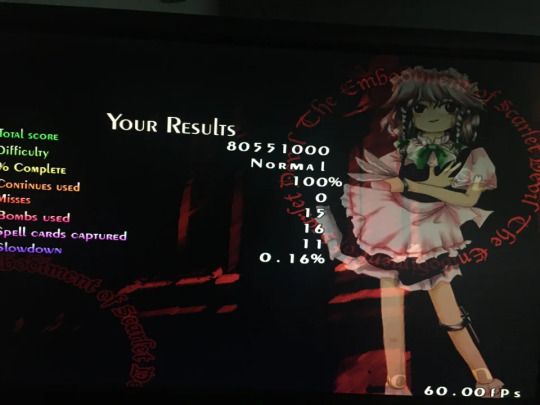
So... yeah. I might be a Touhou fan now. Welp.
Touhou VI: The Embodiment of Scarlet Devil was such a pleasant surprise for me: I expected a game I’d find somewhat boring at best and frustrating at worst, but I ended up having a very, very good time, and honestly? It’s not as hard as you’d think it is! You can beat a Touhou game, so long as you are interested in practicing and getting better, and I promise it’ll feel rewarding in the best of ways <3
I just wanna say thank you to Luna Nights and Team Ladybug, because without them, I would have never been curious and then surprised by how cool this game is. Thank you <3
And many thanks to you, the reading, for staying until the end! Thank you for reading!
10 notes
·
View notes
Text
Phantasy Star II - The 1989 JRPG that could
(This post is dedicated to @kuukigajan, my best friend, whom motivated me to post here again, so... I hope you'll enjoy this!)
This game. This freaking game.
I'm gonna say it right now: this post will contain massive spoilers about pretty much everything in Phantasy Star 2's story, so if you do plan on experiencing this game fresh, I strongly advise you to not read this post at all beyond the first paragraph, but... here's the gist of it: Phantasy Star II is one of the most important and groundbreaking JRPGs of its time, and I just did not believe this game was from 1989, at ALL. For that and a few other reasons, it has become one of my new favourite games of all time <3
In fact, I do want to start with the one big flaw of this adventure so that I can just gush about everything else that's brilliant about PSII. I have to be honest: the dungeon design in this game is horrible. Now to be fair, it does make the many places you visit more memorable, but well... there's a rumor floating around that an actual trainee made the layouts for the dungeons - and since this game was a bit rushed for the Genesis's launch, the devs just didn't have time to replace the... stuff he submitted. And let me tell you, this rumor makes sense: PSII's dungeons are too big, too maze-like, too confusing and also FILLED with strong enemies. And in a game where you don't get a way to save anywhere until the midway point, it can make your adventure very frustrating and potentially grindy because of that... Now I wouldn't say that PSII's nearly as bad in this area as say, the original version of Dragon Warrior or ironically the first Phantasy Star, but the dungeons can totally make you feel like the game's harder than it actually is, at least without a map.

Thankfully, you should never feel bad for using any maps or guides with this game! The execs at SEGA at the time made the very smart decision to include a walkthrough with each copy of the game, including maps, tips, secrets and more! Said guide does encourage youto not look at it as much as possible but... it's totally fair to just use this, without any shame!
And that is a great thing, because... with you armed with this piece of paper, Phantasy Star II can finally show you its actual brilliance.
The game's plot starts off a thousand years after the events of the first Phantasy Star game. Since Alis and her party defeated Dark Force, the inhabitants of the Algol solar system - and its three planets of Palma, Motavia and Dezolis - have enjoyed relative peace. However, at a (to my knowledge) unknown point in time, a computer entity known as Mother Brain has started imposing itself onto mostly Motavia. This, over time, has actually given many benefits to the region: the once deserted wasteland was given rain, water and crops, so that it could finally host viable, comfortable civilizations. The citizens that lived here could finally ditch their (arguably) nomadic, harsh lives in favor of comfort, pleasant weather and more. And most importantly, Mother Brain allowed its citizens, save for a few, to ditch their current jobs and live a life of laziness, without any obligations or pressure to do anything other than well, existence. This is reflected many times during the game through NPC dialogue, too!
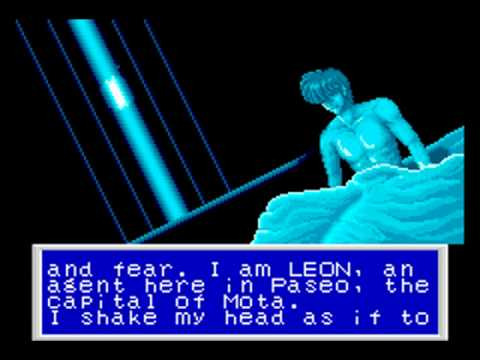
It is on such a setting that our protagonist, Rolf, wakes up from a strange nightmare. In it, we see Alis batting Dark Force and struggling in doing so, but as soon as he realizes this, Rolf wakes up in cold sweat. He then proceeds to calm his nerves, realizing that no such dramatic events could possible happen to him - after all, he and many others have been under the universal protection and care of Mother Brain, whom at this point, has provided all of their needs for centuries. He then gets out of bed and goes to the central tower, where we works as an agent in case some things do go wrong.
And gone wrong things have! His superior informs him that biological monsters, which had been created and bred in the Mota biosystems laboratory, have gone rogue and infected the regions of Motavia at a rapid rate. Because of this, Rolf is asked to investigate the cause of this phenomenon. Once he gets home to prepare for his journey, he is ambushed by best girl Nei, who has been rescued by him many months ago from the clutches of a serial killer. She does not want to be left alone anymore, and since she is also worried for Rolf's sefety, asks him to accompany him on the mission. Naturally, Rolf accepts.
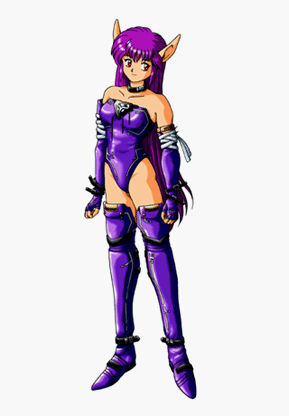
Here, I do want to bring up Nei in more detail! She's in fact, the first of PSII's brilliant story-gameplay interactions, and here's why! Nei is in fact, a crossbreed experiment between a human and an unknown animal with cat-like features, but here's the thing: this said experiment was a failure. Because of this, Nei is only one years old, and yet her physical and mental age are progressing way more rapidly than they should. And you can feel this effect on the game itself: she needs way less EXP than any other party member in the game to level up, and because of this she will skyrocket in levels way beyond the rest of your crew... with a catch. Because of the nature of the experiment, the genetic code inside of her is slowly being messed up and corrupted, which not only causes her level ups to be less valuable than anyone else's, but it also becomes an important plot point later... Unfortunately, despite her absolute cuteness, her status as a half-half made her a victim of bullying, racism and so much more, which is... pretty messed up to bring up at the time not gonna lie o_o
Starting up the journey, the party discovers that rogues have destroyed a neighboring city, and it just so happens that their base is situed at Shure, the first dungeon of the game . One assumption I like to make from this scene is that life has become so easy and careless on Motavia that people just went and did crime out of pure boredom, because life just wasn't thrilling enough anymore with Mother Brain doing everything it could for its inhabitants...
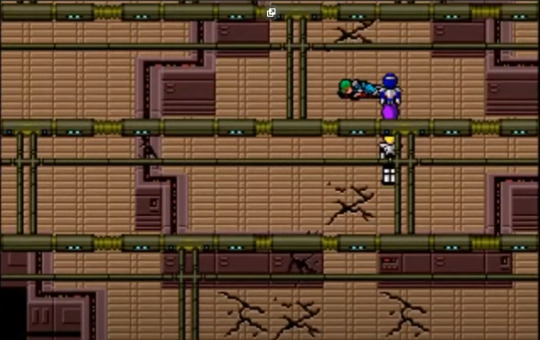
However, upon climbing said tower, Rolf and Nei find out multiple dead rogue bodies, whom have been presumably murdered by the many biomonsters roaming the place. They do, however, manage to find some dynamite and most importantly, a letter. This piece of paper informs our heroes that the daughter of a Darum, the very same person that tried to murder Nei months ago, is held captive in another tower, which explains why he turned to crime in the first place. They then decide to do the obvious, which is to rescue daughter Teim in her captivity location. Once they meet up with her, she explains her desire to talk to her father to set things straight and sway him from the life he's been getting into, as well as hide her from the surviving rogue members with the help of a veil. Our group manages to meet up with Darum, but... her daughter asks the party to stay put, as she does not want them to interfere with her as she explains things to her father. However, in the heat of the moment, she forgets to remove her veil, which causes Darum to not recognize her. In his confusion, he murders her own flesh and blood and sits there, stunned, as he watches the reason he caused many untold atrocities... wither away below him. Shocked and going insane by this situation, he sees no other way out... but to commit suicide with the help of a bomb.
It gets worse.
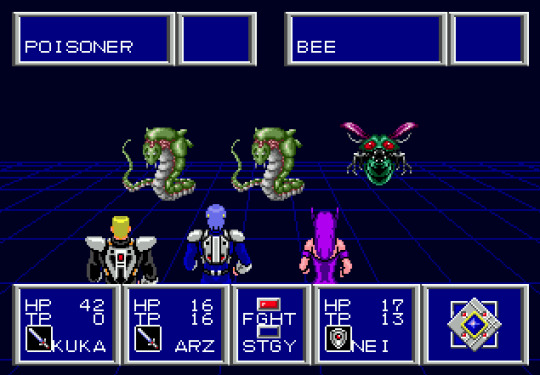
While this scene was tragic and brutal to say the least, it does allow Rolf to cross the previously guarded bridge where Darum was always located, which allows him to investigate his mission further.
I do want to make a sidenote here actually! Phantasy Star II does include eight playable characters, but unlike Rolf and Nei they do not join you at fixed intervals - instead, they will become available in your home town of Paseo once conditions are met. Sadly while they do have a recruitment quote, a few lines and a backstory, they do not have an impact on the main story in any way. This does blow as this means PSII does not have much in character development and interaction, but I did want to mention that there’s more to this game than just Rolf and Nei :P
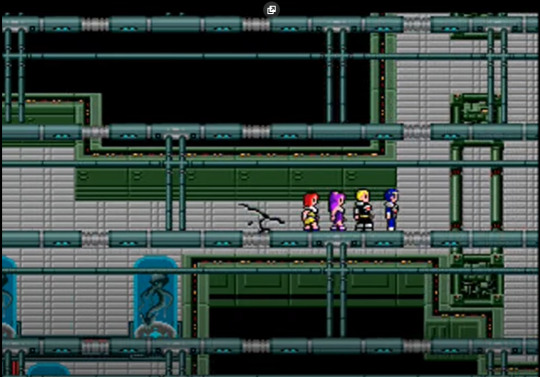
Upon exploring the regions of Motavia, the party manages to make its way to the Biosystems lab, and what they find here is horrifying to say the least. The lab is in horrible shape, with cracked floors everywhere. On top of that, there is no one inside the lab anymore, it being completely deserted, save for some horrible-looking creatures being kept insides tubes, decorating the now sinister looking building... Because of this, Rolf deems it safe to pick up the recorder inside the lab, to analyze it and try to find out just what exactly went wrong - if anything at all - to hopefully figure out why the world has been sacked by biomonsters. And sure enough, the gang make its way back to Paseo. After handing over the recorder to the library located in Paseo’s Central Tower, it is now made clear: the biomonsters were caused by a large amount of energy used in a very short amount of time in those labs, causing them to mutate extremely rapidly. This had the predictable but unfortunate effect of ruining the natural order of the ecosystem, which is why these species are wrecking havoc without control. The librarian giving this information also makes the following connection: this outpour of energy must have come from Climatrol - another lab which regulates the weather of the terraformed planet so that it can sustain its new shape. Following this, Rolf and co. take a few steps to reach Climatrol - and I want to highlight a specific one!
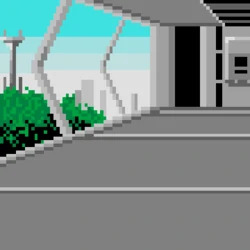
The story somewhat pauses until then, but one of the dungeons you’ll go through is a garbage dump... and one of the treasures is a jet scooter you can use! Sounds cool, right? Well it is, but even such a cool object has been abandoned by the lazy society, since teleportation is much more convenient to them. I just thought it was a really neat detail, that’s all ^_^
Once making their way through the relatively normal Climatrol, something does wait for them at the top of the building... something... unsettling...
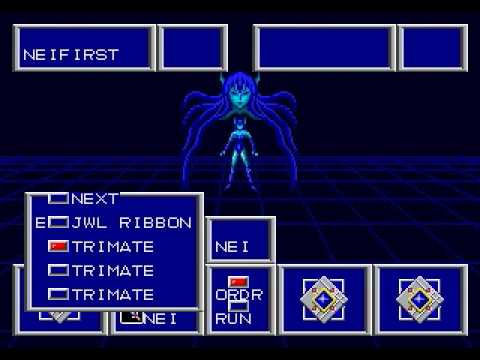
This is Neifirst. She was another failed experiment just like Nei, sharing the same biological data as her. However, unlike her sister, her creators tried to kill her on the spot due to her status. This made her enraged against the species that gave her life, and as an act of revenge, decided to unleash this bio catastrophy to slowly wipe us out. This is where another truth is revealed: Nei did not come with Rolf just to protect him, she actually wanted to put a stop to her sister, because while she did dislike being treated like a freak or a monster, she never wanted to hate her species as a whole... It remains that she still wants to stop her sister’s plans, and despite Rolf’s protests, the two engages in a fight. However, due to Neifirst being much stronger, Nei sustains heavy damage and is incapacitated. But, this is where the rest of the party comes in, and thus they finish the job and kill off Neifirst dead in her tracks, Rolf then quickly rushes in to his dear friend’s side, but as he does... it’s too late... Nei is dead.
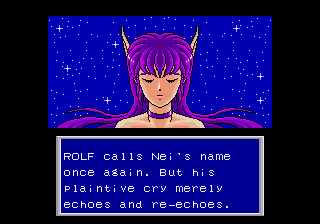
This is yet another reason why Phantasy Star II is such an important game: it is, to my knowledge, the very first JRPG in which a major playable character dies permanently. Heck, Rolf even tries to bring her back through the local Clone Lab - because yes, citizens have access to eternal life by cloning their bodies until the end of time - but... since Nei’s genetic code was degenerating rapidly, they could not clone her body anymore. And, since Neifirst was also defeated, it is also impossible to get a fresh code back from anywhere in the world. Nei is dead. And you cannot do anything about it.
But don’t worry! It still gets worse!
But just as you’re about to find a way to fix this, it turns out that Climatrol has collapsed, which caused an immense flood all over the world. Since the government - and by extension, Mother Brain - isn’t happy about this, you are now considered a fugitive, a criminal. You are now the bad guy, and you are wanted for treason. 1989, anyone??
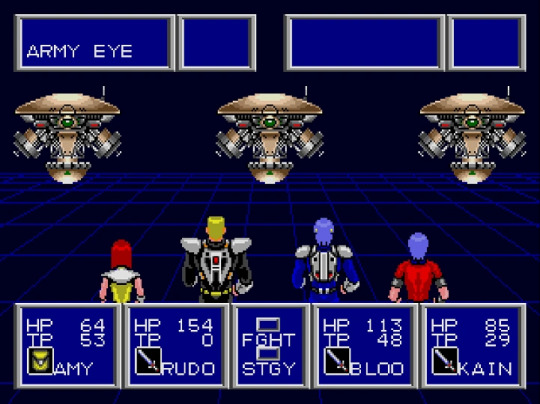
This is where the second brilliant story-gameplay integration of Phantasy Star II happens. Where until now you’ve only fought mutated monsters due to the outbreak, the government has now sent thousands of carious cyborgs and robots against you - and lo and behold, this is now the only thing you are fighting in both the overworld and dungeons, and the previous creatures are now nowhere to be seen. THAT’S REALLY SMART. Now sure, even if you are considered evil to many, you still task yourself with the task of unflooding the planet, and to do so you simply reactivate all four colored dams in the continent. However, upon reactivating the fourth one, your party is suddenly ambushed by a trio of robots sent by the cops, and this time? They succeed in capturing you. Your party is now sent in chains on a hovering satellite, as you are sentenced to slowly wither away and die in there without any trial of any sort, simply because you went against Mother Brain’s dear wishes...
But, something goes amiss. The sattelite starts to malfunction, and is now set to crash on one of the three planets of the Algol system. And despite you all trying to alter its course, it is too late. The satellite crashes onto Palma - the planet of the first Phantasy Star game - and it is gone.
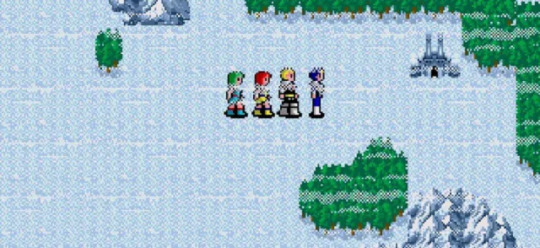
That’s right! The planet in which many players took the time to save with Alis’s gang, to have a huge dungeon crawling adventure, the planet where you defeated Lassic in a glorious fashion. GONE. In only a few seconds. But... what about yourself? Well, you actually died! But a space pirate wandering close to the crash site pulled out your remains and cloned everyone’s body back to life... which makes you technically not yourself, and also dead, for the remainder of the game! ...May I remind you this game was developed in 1989?
Tyler the space pirate then escorts the zombie party back to Paseo, but not for long - you see, your commander, who hasn’t truly approved of Mother Brain’s actions against your group, allows you access to a spaceship. This is a big deal, because space travel as a whole has been banned ten years ago due to a major accident in which Rolf had lost his parents, and thus, the one stationed in Paseo is the last one remaining on the planet. But sure enough, Rolf takes the opportunity and travels to the ice planet of Dezolis, or Dezo.
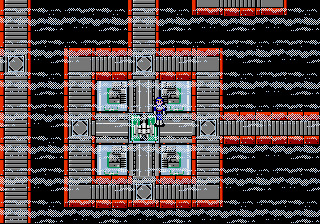
And honestly? Even though this next part has nothing to do with the main story, it’s probably one of my favourites in the entire game. In this section, you simply must make your way through an abandoned space station, which has not seen use in years. At first, you’d think it was somewhat related to the spaceship incident, but as you explore this space station, you find a bunch of animals and newspapers lying around. You not only find some irrelevant ads about various products, but also news flash about a horrible gas spreading throughout the station, begging every inhabitant to evacuate immediately, which... definitively implies a very bleak fate to the place and its inhabitants o_o
And on top of this unsettling setting, this is the first time you get to hear “Silent Zone”, my favourite track in the game. While the rest of the soundtrack is very upbeat, catchy and all around excellent, this track in particular is very... sad, desolate, lonely, in spite of it being just as catchy! It all combines for a brilliant example of “show, don’t tell” that really sets the mood perfectly to me <3
Either way, upon exploring more of Dezo - a frigid wasteland with few inhabitants - the party gets to meet up with Noah, a party member from Phantasy Star I! After reawakening from a cryogenic sleep, he then reveals that unlike Paseo and Motavia, Dezo basically never submitted with Mother Brain’s control and benefits simply because they did not want to live a life without any struggles. Unfortunately, this is also where you learn that Paseo came to terms with this *after* being to MB’s whims and as such, you can connect the dots and realize that the satellite crash was no accident after all... it was all planned.
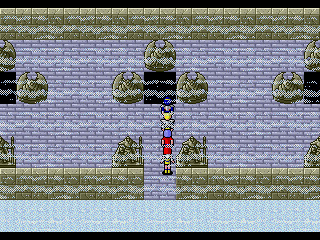
Noah, however, knows about how deeply MB has ruined everything for the inhabitants of Motavia and thus tasks Rolf with collecting eight legendary ancient weapons all throughout Dezo, located within some ruinous, empty, cold dungeons which make for stunning atmosphere and presence, believe me!
Once that’s done, he then entrusts Rolf with the ultimate Sword and, thanks to kinetic abilities, sends him and his troupe to the space station housing Mother Brain. And once there, for the first time in centuries, a human being has met with Mother Brain.
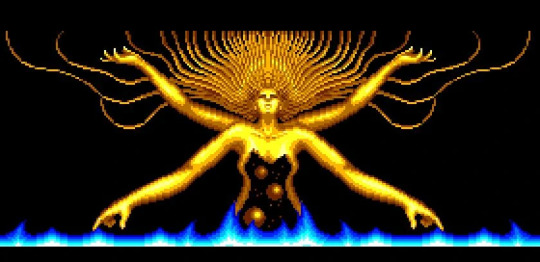
And of course, the computer scoffs at those rebelling against her. She laughs at how they think they’d want a life with struggles, wtihout comfort, without anyone providing their needs, when work and hardship seems so uninviting on a desert wasteland like Motavia, or a frigid hell like Dezo. And yet, after a (pretty difficult!) battle, you emerge victorious! Or do you?
After the victorious outcome, Noah senses some additional presences beyond Mother Brain’s spot, and urges the party to investigate. And then... I don’t think I’ll even explain it in words. Please watch what happens. It is disturbing.
youtube
Yeah. We, the humans, were destroying our planet, Earth. Thus, we escaped through this spaceship to avoid extinction, and found the Algo system. It then, to our species, only seemed logical with so few numbers, to instead slowly weaken the population of all three planets with Mother Brain, making it then easy (although a very long process) to get rid of the population and start anew, even if it meant genocide. What I love about this twist ending is not only how it’s presented: the creepy music, the way you did *not* expect it at all, the number of humans on the screen at once, and so on... but also, how you don’t even know for sure how it ends. You don’t know if Rolf, Rudo, Amy, Kain, Hugh, Shir, Anna... if any of them survived. But it looks grim. It looks like we lost. And it looks like everyone we fought and tried to save... will rot until the final days anyway... Phantasy Star II... is important. Sure, I could talk about how the game is challenging due to how both your party members AND the enemies are very capable in battle or the stellar, catchy, memorable soundtrack... but its story... is stunning. In 1989, we were still used to princesses being saved by armored heroes from dark dragons. We were used to things going all well in the end. But in 1989, Phantasy Star II taught us many things that would become staples in the future of JRPGs: Yes, your cherished ones may die with you not being able to do anything about it No, you may not be able to save everyone you’d like to. Yes, your actions might make things worse for yourself and everyone else. No, things aren’t quite as black or white as they seem. And no, you might not always win. Phantasy Star II is a masterpiece. It’s a bit hard to approach this game today, but with a guide, this game is a must play. It’s unique. It’s ambitious. It’s chilling. And I adore this game to pieces. Thank you for reading, somehow <3
27 notes
·
View notes
Text
Lost Sphear review! - I Am Setsuna: the sequel!
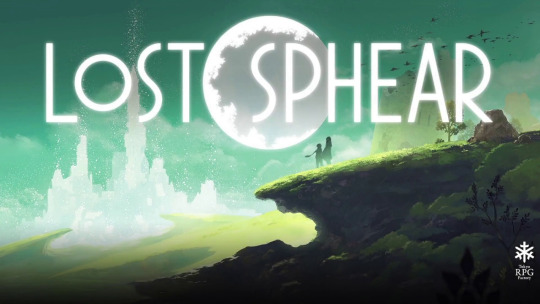
I am finally back from being... honestly much lazier than I should have :P In my defense! The reason why I haven’t started writing this article just yet is because I became addicted to the game I’ll be reviewing next~ But to be honest with you all - and I’ll jump the gun a bit as well - this game... well, it’s honestly a bit hard to write about it for me ;-; I might as well get the basics out of the way though: Lost Sphear is a JRPG by Tokyo RPG Factory, which you may know for being the devs of I Am Setsuna a few years ago! Sadly, both games have gathered a pretty mixed reception from both critics and players. I personally adored I Am Setsuna despite some of its issues, due to how unique it was in many aspects, so naturally I was really hoping Lost Sphear would be a magical experience that would polish some of the flaws of IaS
And... I think they did too good of a job at that.

First off, for those who did not play IaS, let me tell you first that you absolutely should, especially since it’s decently short, at around 20 hours! But if you did not and don’t plan to, there is no story connection between two of those games - although some enemies and assets are reused in LS, and the battle system s largely the same. In fact, let’s start with that! I am very relieved to say that combat in LS is possibly even more fun than ever! It still uses the same base as in IaS, as you still have a normal attack command, as well as skills that can be physical or magical special attacks, as well as special buff and debuff skills. Y’know, typical RPG stuff. However, just like in IaS, this otherwise very simple combat is complemented by the absolutely lovely Momentum mode, which is a bar separate of your normal Active Time Battle bar. It fills up whenever you complete an action OR wait before you choose a command. If it fills completely, you can store a special orb tied to that character (up to three, in fact), which you can then activate along with an attack/skill for extra damage or effects if you can time it right! This mechanic is in short, AMAZING. It makes you think about when to use that extra boost, when to attack enemies or use skills, and the fact that you need to time it makes battles very engaging! But keep in mind, all of this was also present in Setsuna, so how did they make it better here? Well, Lost Sphear actually allows you to move your characters around the map when battling! This allows you to place them to avoid attacks, as well as hit enemies as efficiently as possible! LS also introduces Momentum Boosting, which allows you to customize whatever skill you chose to put on your party member with special effects, like healing or elemental damage! Those two changes, while it makes experimentation and battling even more satisfying, does make regular battles even easier than in IaS - though you CAN make the game harder in the settings at any time if you find regular battles to not be exciting enough! That, and the bosses are usually decently strong anyway :P
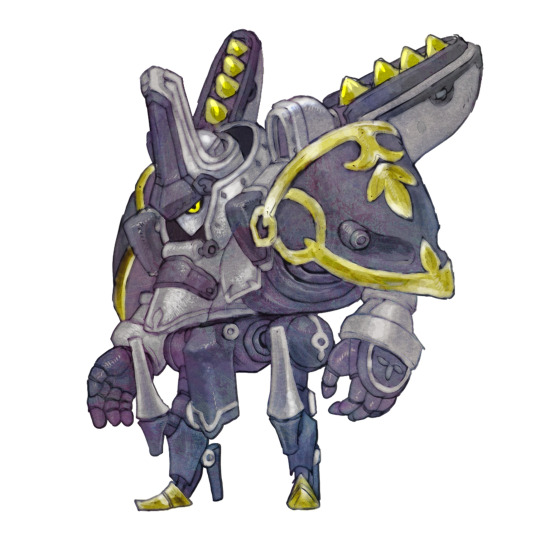
Another notable feature are the Vulcosuits! These are a new combat feautre you obtain relatively early in the game. While using them spends some pretty limited VulcoPoints, it does boosts your stats, and most importantly allows you to perform special attacks either alone or with a party member (and you can have up to four of them in a battle instead of three now!) This is a pretty cool system, and I’m glad that they incited you to not overuse it by limiting the VPs you can get. But sadly it also makes so that you cannot do combo skills with a partner like in IaS, which I always thought made battles more fun and strategic too ;-; If I’ll fault LS’s gameplay somewhere else, it’s how it had a tendency to spare you of checkpoints sometimes. It’s not a very constant issue, but I sometimes had to fight a boss after not having a save point given to me for minutes - and it made me lose 40 minutes of progress once, so that was fun :/ But besides this and a couple of annoying bosses, I can say that the gameplay in LS is overall better than its prequel!
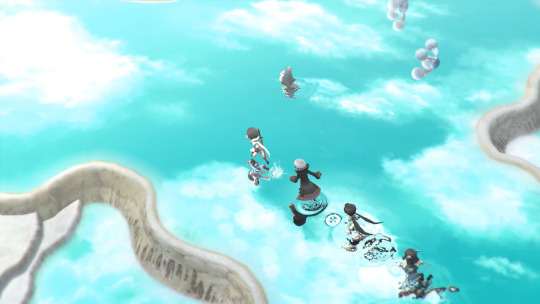
Sadly, gameplay isn’t what’s the meat and potatoes of any JRPG, so what kind of setting are we dealing with this time? Well, this is where I think Lost Sphear starts to fall flat. After a mysterious flashback sequence, we start off in the small village of Elgarthe, where we meet with Kanata, Lumina and Locke (no, not the treasure hunter). As we do, a strange phenomenon starts to occur, where we see the entire town being enveloped in snow-like mist, which translate to the town being “lost”. Curious to see why this even happened at all, our main trio, which is quickly joined by the strange, emo Van, set out in an adventure to not only find out more by visiting the capital of this game’s empire, but also to restore whatever lost things they come across. Why? Because Kanata - for reasons I will not go into - has the ability to make things return to how they are if he has enough connection/memories tied to them! (As a side note, you can even gain some stat bonuses/effects of your choice by restoring specific points on the map This setup is decently interesting, but to me? I feel like it’s not enough to really keep me engaged ;-; It’s certainly not bad, of course not, but I found it a bit boring and cliché at times to be honest. Without going into specifics for spoiler reasons, it’s a lot of “the empire is bad” and “we can save the world” and “we’re the good guys”, which while not horrible plot devices, aren’t very engaging either.And that same point extends to the characters as well ;-; I do think some of them are quite good, but even then I did not really fall in love with anyone, like I usually do in most RPGs I play, which... well, sucks. There is a few characters with neat backstories and events happening to them (such as Van, Galdra and Lumina) but overall even these three just didn’t have enough to them for me to become attached ;-;
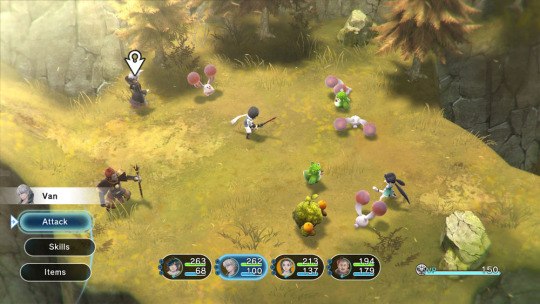
And welp... this goes true for the music and art of LS, too. Now, I wanna say that the soundtrack to Lost Sphear was actually pretty good overall! Just like in IaS, the village themes are beautifully peaceful and relaxing, and the battle theme has a nice ring to it as well, to give just a few examples. And this time, the composer actually learned the existence of instruments other than the piano! However, I do think that the minimalistic soundtrack for IaS was a lot more memorable overall - not just for how much it stood out for that reason, but also because I think the compositions themselves were just a bit more memorable ^^ But I get that most people prefer variety, and music taste is pretty suggestive anyway :P And I also get that a more standard soundtrack - which is still good, mind you! - would fit better in a less unique world - and speaking of...

The world of LS is a lot more typical of what you would find in a RPG - you’ve got your remote villages, your massive empire city, your port areas, and so on, all presented in a grassy setting. I know this is a very strange statement to point out, but despite Lost Sphear having some very pretty shots from time to time, I really feel like it matters when you compare it to its ancestor. One of the things I loved about IaS was its snowy, setting, which blended perfectly with the minimalist piano soundtrack to create a breathtaking atmopshere. And while what’s there still works - and is much more varied for sure - I feel like a lot of the soul was lost in the atmopshere given to the player. And honestly? I think this sums up the game very well.
Lost Sphear is a good game. But that’s exactly why it was so disappointing to me. It’s just “good” and ultimately forgettable. IaS, while not perfect, blew me away with its charming cast, beautiful music, breathtaking setting, unique story and fun battle system. And while that last part is still there and mostly improved, this game, by being so much more by the books, is not nearly as interesting ;-; The story is fine, but I do feel like I’ve heard most of it before. The characters are okay, but they just don’t do enough to be nearly as likeable as I want them to be. The graphics and audio are both solid too, but again it’s just not the same. Don’t get me wrong, Lost Sphear is a solid time. But as far as RPGs go, I feel like the player should be impressed, and LS... just doesn’t do it. I definitively recommend going through I am Setsuna first <3
Rating: 7.2/10

16 notes
·
View notes
Text
The Legend of Zelda - The Wind Waker! (HD Turbo Championship Edition)
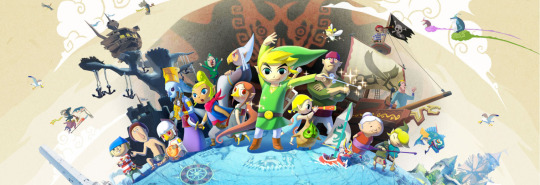
Hi everybody!
As I plan to revisit many Zelda games I haven't played in years (or at all!) in the upcoming months, I finished what used to be one of the most controversial titles in the series for the second time, and the first in four years! And to my shock considering what I've heard about this adventure over time, I fell in love with it all over again 💗
I'd actually like to start this humble review with this analogy: What surprised me the most while replaying this game, is how its overall structure and world are. I feel like the best way to describe this game is like this: A perfectly balanced mix - as all things should be - between a classic Zelda quest, and the much more revolutionary Breath of the Wild. Now, I gotta say, it may be strange to some people to compare an older title to a newer one to describe it, but I promise it'll at least somewhat make sense at the end of this review... I hope O_O
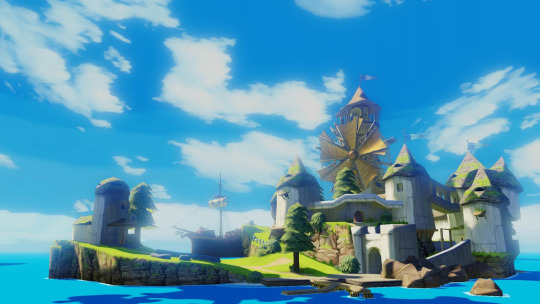
But hey, we might as well review the plot early as usual! Well, there honestly isn't a lot to this story as usual for most Zelda games, but it is pretty solid regardless. Basically, as the ambient intro of the game teaches you, the ancient land of Hyrule got flooded by the gods, as Ganondorf tried to conquer the land with no Hero opposing him. And ever since that event, the world has been flooded with the Great Sea, only leaving many small islands and some people behind to rebuild the world. And so, many years after this happened, we find this game’s Link on his 12th birthday, wearing the “Hero of Time’’s clothes for the occasion as a longheld tradition. BUT, as this supposed happy day happens, his sister Aryll gets kidnapped by a giant flying bird to the Forsaken Fortress - as many other young girls. Naturally, Link tries to go save her with the help of Tetra - another young girl that escaped captivity thanks to her crew of pirates. With the help of her companions and their ship, Link sets out for the fortress, but as he is clearly underpowered, he gets demolished there by none other than Ganondorf, and washes up ashore, unconscious on Windfall Island, greeted by... a talking red boat! And this same boat tells him he must collect the Three Pearls of the Gods in order to gain access to the Master Sword, to finally save the kidnapped girls! This is not the whole plot of course, as I’m hiding some actual plot twists from you, the reader, buuuut I will say that while it’s not the most developed tale out there, it’s well done! But I feel like what drives this the most is certainly the art style and the characters themselves. See, I firmly believe this game has the best Link in the ENTIRE SERIES, no questions asked! He’s expressive, funny, endearing and he just looks so dang adorable! Part of his charm is definitively thanks to the situations he’s put in, but I think it’s mostly because of the game’s artstyle. IT’S BEAUTIFUL

Yes, granted, it’s not nearly as detailed as many games you’ve probably played, but the cartoony style they chose for Wind Waker really makes the locales pop out, and made the slapstick in the game that much more endearing! Plus, some of those shots just look, well, breathtaking really.
Speaking of character expressions and slapstick, I also believe Wind Waker possesses a very memorable set of NPCs as well! Be it the employee in the battleship game with his twofaced personality, or anyone involved in the many sidequests all over the islands, I’ve built lots of memories just traveling all around the sea, reading and delivering letters, just to get to know those people more! And it turned out that a good chunk of them gave me a good time!
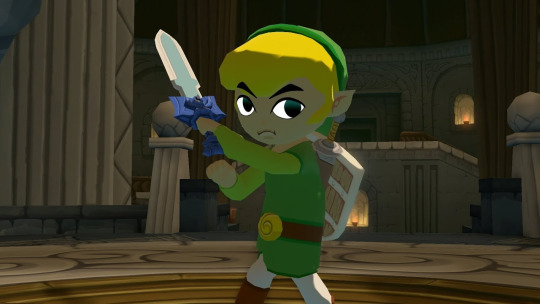
Well, let’s talk about those travels, shall we? Wind Waker got (in?)famous over the years for having sailing. Lots of it. And especially in the original Gamecube version, it made travelling slow and boring to some as a result. Basically, you needed to constantly change the direction of the wind in order to travel as quickly as you could. Suffice to say, switching the wind’s directions this often got irksome pretty quickly : P Thankfully, the HD port on the Wii U does give you an optional Fast Sail in a side quest! As early as the second island in the game! Which means that those who found the sailing unbearable in the original will have a better experience ^^ But regardless, there’s a lot of sailing in this game, which is what replaces running/rolling around on the overworld. And instead of having different regions, they’re all replaced by 49 islands of different sizes and importance! And this is where my BOTW comparison will shine~ I think this game is pretty close in spirit to Breath of the Wild in some ways. Sure, unlike in that game, you’re locked to a certain sequence of items/dungeon/progression, just like a classic Zelda experience! BUT! Wind Waker also allows you to explore 40+ non-important islands, and sailing between them in anticipation of what you might find there is suuuuch a good feeling! Plus, there’s many treasure chests to loot (both major and minor) while you’re travelling on the big blue. Due to how much you can find in your way off the main quest - while being far away from the suggested path the game wants you to do at the moment - gives this game a very open feeling despite still having a linear quest to it! And I think this element of discovery and exploration in a linear format - coupled with the great visuals and ambience the sailing offered - made this game so, so, so much fun to play <3

But what about the gameplay and dungeons themselves? Well thankfully, they’re both quite good as well! What I like most is how much of an improvement swordplay got compared to Ocarina of Time. Not only are the enemies generally more diversified in strategies and design, Link also received many new moves to his arsenal, and those made combat so much more intense and exciting! Though it did make the game very easy overall thanks to having so many options... alongside you not taking very much damage for most of the game :P Still, the dungeons made up for this! They’re quite fun and pretty well paced, and each offer some quite nice ambience as well! Although I will say that the late part of the game has two dungeons with pretty similar concept, which while fun in their own right, did feel a little uninspired despite them having clever puzzles :/ On a semi unrelated note, the intro sequence at the Forsaken Fortress has you playing a stealth sequence, and you coming back to it later while able to defend yourself was a high point for me!

I do want to leave a quick note about the music, and honestly? It’s pretty great as well! Like I pointed out earlier, the dungeons create some very fitting atmosphere, but as soon as you’re outside them, many of the main islands have some very pretty, energetic music that is PERFECT for a Zelda game (especially Dragon Roost Island), and the Great Sea theme is very adventurous and grandiose, which motivates you even more to set out and explore! Though it’s somewhat strange that many smaller locations have no music at all, which makes sense to be fair, since those islands are usually pretty small from the outside ^^
Overall? I expected to only like this game, but I ended up adoring it! The Wind Waker is a marvelous journey that leaves a lot open to the player about how they approach the game, while still giving you enough of a compass to never be lost! And a competent story with charming characters and great music certainly help to make that adventure all the more memorable! Though I suggest you all should play the HD version if you can, since it has the fast sail and better looks. BUT, it also heavily tones down the infamous lategame Triforce fetch quest. (While it did not make much sense story-wise since you could just do spoiler without it before, I didn’t find it all that bad in the HD version since you can do some of it before having completed all other dungeons in the game ^^ But yes, HD or not, this is a grand adventure! Play it! 9/10
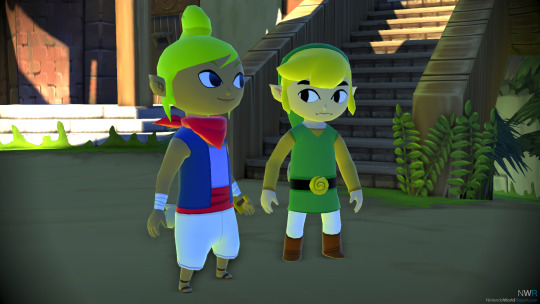
6 notes
·
View notes
Text
Hi! ^^
Welcome to my new, infant blog! I'm just a gaming enthusiast, and by writing a bunch of things here, I'll try my best to entertain you with articles about whatever I've been playing recently! I hope you'll enjoy your stay <3 See you soon!
4 notes
·
View notes
Text
The Legend of Zelda - Oracle of Ages and Oracle of Seasons!
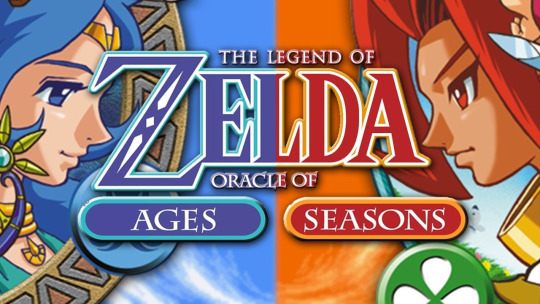
Hi peeps! I recently managed to finish both parts of the most unique set of Zelda games, Oracle of Ages and Oracle of Seasons! Since those games don't get a lot of attention, I just wanted to do a (long) writeup on what I thought about those two!So let me get this out of the way first: To my disappoint but not to my surprise, the game still uses the same inventory system as the original Link's Awakening - and a very similar engine as well - which sadly means that the frustration of having to CONSTANTLY switch items in the menu is still very much present. So if you couldn't get into the original LA for that reason, I can tell you right now that this game will not be a good time for you no matter what ;-; Now...

As far as the story goes, I'd say it's pretty typical - and even similar between both games. At the beginning of each story, the game's respective oracle, Nayru or Din, get captured by either Veran or Onox, and it's up to Link to collect eight various artifacts that will break a magical barrier keeping him from the omnious castle of the big bad guy of the day! Just like many games of the era, there is little to no story progression (though I think there's slightly more development in Ages compared to Seasons) but on the flipside, there's nothing here that struck me as dumb or bad, just... not very detailed.And while that's definitively fine for the era, let me say this: I feel like Link's Awakening had something much more interesting going on. I won't spoil it for those who haven't played it or its remake, but I feel like the Oracle games are much lamer and less inspiring in that regard, and combining that with how not much changes in the plot unlike in LA, I couldn't help but be disappointed by this.

And honestly, I'll hold the same opinion for the soundtrack as well. Again, it's not bad! But first off it reuses a couple of tracks from LA, including the overworld theme which... didn't really sit well with me. But although the dungeon and village pieces set a nice tone for the game, I think LA did that better thanks to having more memorable tracks overall ^^
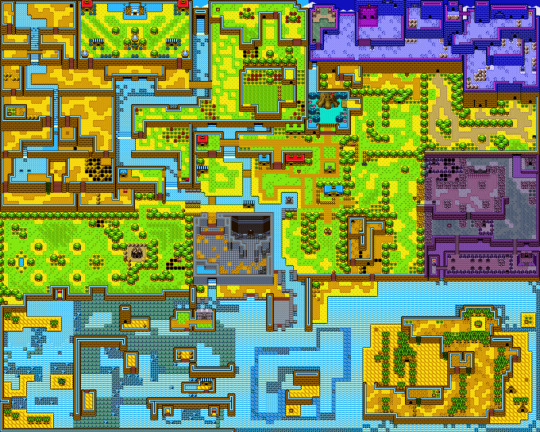
However, fear not! Those games have some very nice improvements regardless! Like I said earlier, the engine is very similar to the one used in LA, but the game looks much more colourful and bright than its ancestor, and I did find the menus to be a bit faster and more responsive as well. Plus, the screens can actually scroll now! Hurray!But what about the game itself? Well, one common point brought up by players of those games is how Ages is centered on puzzle solving, while Seasons has a more combat-oriented approach. Let me tell you right now that this is NOT true at all. I'd almost argue Seasons has more puzzly action, but that might be stretching it a bit :P Either way, I think both games are very similar in structure, story, and dungeon/overworld design, But thankfully, most of it is pretty fun! The dungeons are especially good, with some very clever and creative puzzles. I would even argue they are the best in the entire series overall gameplay-wise, though not very memorable as setpieces. I will say, I had to look up a walkthrough many times, and although I felt dumb for not realizing what to do on my own many times - and the games are also pretty good at giving you a general direction of where to go - I do feel like the solutions to certain challenges can be pretty cryptic and offputting.

As far as overworlds go, once again while they're fine, I didn't find neither Labrynna or Holodrum very memorable. The major difference between those two - besides the layout and name - is how you travel in those places! What I mean is, in Ages/Labrynna you'll be able to time travel just like in A Link to the Past, and solves problems that way! While in Seasons/Holodrum, you'll be able to change the seasons on the overworld in order to change how the environment is laid out around you! This does make traveling in those overworlds very prone to backtracking/back and forth, but it felt pretty satisfying to figure out how to go through on your own!Like I said earlier, the gameplay is overall very similar to LA, but I'll say that it overall feels better as well. The engine has recieved a nice upgrade, but this is mostly thanks to what I think is the biggest strength of the Oracle duo: THE ITEMSTHEY ARE SO MUCH FUN!

They give you some very creative and unique spins to items you're very familiar with in the Zelda series, such as a Magnet instead of a Hookshot, and they build up on some already very fun puzzles! I'll also add that many cool items from LA come back as well, such as the feather! There's also a few new mechanics unique to this game, such as Gasha seeds (basically planting seeds over the world to gain treasures later) and rings (which can grant you unique effects when you wear them). I do like the ring system overall since it makes Link more customizable, but I wish that more than a few rings were actually useful ;-;Lastly, let's talk about what makes those games stand out even more from the rest: Secrets! Basically by completing one of the two games, you can gain a secret password that you can enter in the other, which grants you a few benefits, such as one more heart at the start, plus skipping a part of the intro sequence. Furthermore! You can talk to certain special NPCs, which will grant you shorter passwords that you can then give to another NPC in the opposite game, who will then give you an otherwise unavailable upgrade for both games! This not only makes the games feel special by being physically connected, it also boosts their replay value since you can totally play those games in the reverse order next time you dabble with the oracles!

But overall? I definitively think well of those games, but I find them pretty hard to rate. On their own, they're fun to play but nothing special otherwise. I did find Ages slightly better than Seasons thanks to a better narrative and dungeons, but they're both about as good as each other really :P But together? The Oracle games are a very unique experience that, while I still think they aren't as special as LA for their setting alone, are still memorable thanks to the games being linked!
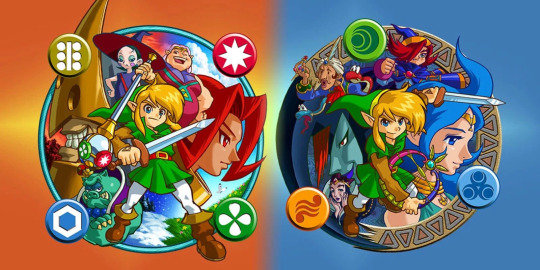
4 notes
·
View notes
Text
Mega Man 11 review!
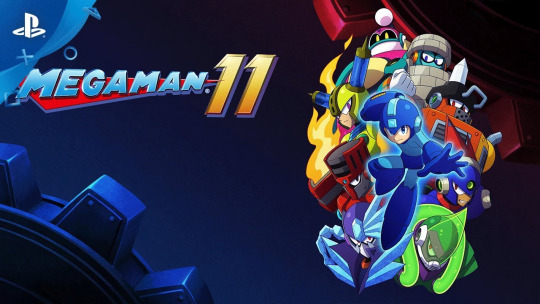
Hi everyone! I actually received this game a bit above a year before this review for Christmas, but due to many reasons including being scared of it being disappointing, I did not play it until writing this post ;-; BUT, I FINALLY stopped putting it away out of fear, and FINALLY started and finished Mega Man 11 yesterday!And I am very happy to say it is an excellent game, that exceeded my lowish expectations!I feared that the generation leap and the double gear system would destroy the game, but to my surprise, this game was overall a super fun experience <3
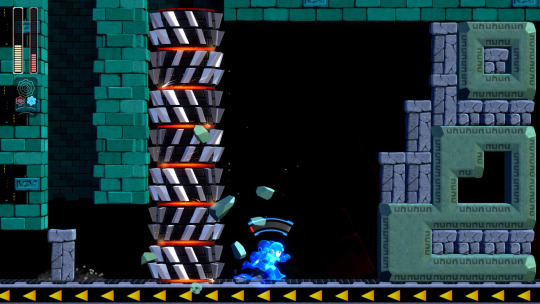
This game for the most part featured some of the most fun stages in the classic series! Each of them had unique, cool elements that made them stand out, fast paced and intense to go through, and for the most part, it was still well designed and fair! I think this game might also feature the best set of special weapons in the classic series, if not the whole franchise! I found myself almost overusing weapons for once due to how useful almost all of them were - which rarely happened in other games! - and it just made the game that much more strategic and fun! MM11 also contains my new favourite weapon in the series, the Blazing Torch! IT'S SO SATISFYING TO BREAK THEIR SHIELDS WITH THIS ONE
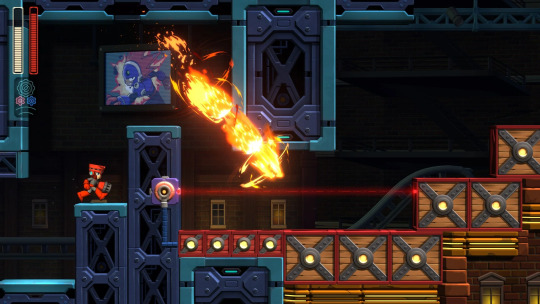
As far as the double gear system goes, I found it to be very fun, albeit a little *too* powerful as well ;-;The Speed Gear especially makes some tricky platforming challenges very "cheeseable", but I'd be lying if I said I didn't *enjoy* spamming it. The Power Gear was overall less useful, but I like how all weapons (and not just your buster) are souped up as well! It reminds me of the X games for that reason <3 But once again, it really cheeses many bosses in the game - which is a shame, since I found them to be especially cool to fight without the gear, or even the special weapons!So yes, gameplay-wise, this game is absolutely phenomenal! But they were still a few hiccups in the level design. Bounce Man's stage is a great example of that sadly, with the yellow platforms being... well, very awkward to use

The rest of the game doesn't stand out quite as much - but I don't think it really needed to, to be fair :P The VA is surprisingly okay, and while the graphics did look somewhat cheap to me at first, the artstyle itself grew on me the more I played! And I honestly can't even explain why -_-Sadly, I think the big flaw of this game is, shockingly, the MUSIC. I don't think it's bad per se, but... I legitimately only remember three or four songs from the game (which were good, but not fantastic) and I found the rest to be pretty forgettable. I think the synth instruments might explain that, but still :/But regardless, Mega Man 11 was a great time overall! With some fun, interesting level design, extremely useful weapons, a cool double gear system, and decent presentation, I honestly think this one might me one of my favourites in the classic series!Please play this one if you can! It offers multiple difficulty modes and is available on most platforms too <3
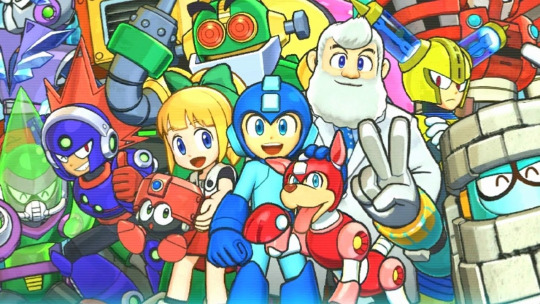
2 notes
·
View notes